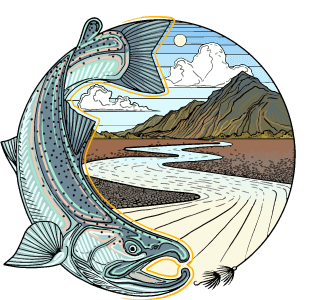Question:
i'm fishing in cardova for sockeye for the first time and need any tips on flies and technics i should know before hand or any thing i sholud know.
thanks...jon from hawaii.
Answer:
Hi Jon from Hawaii,
Thank you for reaching out regarding your upcoming trip. I’m guessing that you have looked through our sockeye salmon section. There are two basic types of flies for sockeye. Both types tend to be sparsly tied compared to patterns tied for the other species of salmon. This is because sockeye mainly eat zooplankton (krill/small shrimp) and are not as likely to chase down their food. Because of this, they are not as aggressive towards flies. It was even once thought that sockeye wouldn’t eat flies and that the only way to get them was by using a technique called lining or flossing where you basically swing a fly trying to get your leader to get caught in their mouth(I’ll dive into to this in a minute.) When the leader gets pulled through the mouth, the hook gets lodged into the jaw. Basicallt when sockeye first come into the rivers, they are on the move and focus on getting to where they need to go and nothing else… zoned out!
The lining technique can be done either by using a fast sinktip in the 15-24′ and a 5′ leader or using a longer leader 9-10′ with a lot of split shot about 30″ up from the fly. Cast stright out, mend a bunch to allow the fly to drop and let it swing at the end. If your hooking fish on top of the head, you are too light and under the jaw/belly your too heavy. When you hook up, you’ll often feel the fish swing it head from side to side. This technique is a must on rivers like the Kenai, Gulkana and other big drainages where the sockeye stream upriver by the thousands. Here you are fishing the larger fly patterns with larger hooks (size 4-1). Check out the Sockeye Killer and Sockeye Fly. Color doesn’t matter as much with this technique.
One thing we’ve learned is that if you can find sockeye where they are pooled up and holding, they’ll eat a drifted fly. Here we’re basically using a nymphing technique where you cast your fly up river or to the top of the pool, mend and high stick it as the fly drifts down. Usually you use a floating line, 7.5-9′ leader with a piece or two of split shot abou 18″ up from the fly,just to get it down a little. When one grabs using this technique, your line will go tight for a split second. Set the hook and get ready for an eruption. Popular patterns are the Sockeye Lantern, Sockeye Lightning and Mercer’s Sockeye Fly in greens, chartreuse, red and orange. One other pattern that can be good on the Eyak is the Copper Swan in silver.
I hope that this is helpful.
Best,
Mike

